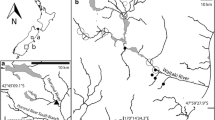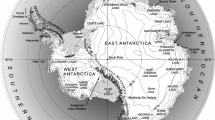Abstract
Budding and prosthecate bacteria were enumerated in spring and summer by viable counting procedures in several freshwater habitats in Australia including oligotrophic lakes, a mesotrophic lake, and eutrophic ponds.Caulobacter spp. were the most numerous type encountered. They were present in the highest concentrations (exceeding 1000/ml) in the mesotrophic lake during the summer. Their proportion to total viable heterotrophic bacteria was also highest (35.1 to 37.7) in this habitat. From 17 to 330/mlCaulobacter spp. were counted in the eutrophic habitats where their proportion to total viable numbers was less than 1.0%. In the oligotrophic lakes they varied from 5 to 23/ml and comprised greater than 5% of the total viable count.Hyphomicrobium- like bacteria were also numerous in the mesotrophic lake and in one oligotrophic lake during the summer sampling period.Ancalomicrobium spp. occurred in high concentrations (130/ml) in the mesotrophic lake. Budding bacteria of thePlanctomyces-Pasteuria group were most numerous in the eutrophic habitats where as many as 240/ml were counted; their proportion to total heterotrophs remained relatively constant regardless of trophic state, however. A similar pattern was observed withProsthecobacter spp.
Similar content being viewed by others
References
Bauld, J., and J. T. Staley:Planctomyces maris sp. nov., a marine isolate of thePlanctomyces-Blastocaulis group of stalked, budding bacteria. J. Gen. Macrobiol.97, 45–55 (1976)
Belyaev, S. S.: Distribution of the caulobacter group of bacteria in the Volga-Don reservoirs (English Translation). Microbiology36, 130–133 (1968)
deBont, J. A. M., J. T. Staley, and H. S. Pankratz: Isolation and description of a non-motile, fusiform, stalked bacterium, a representative of a new genus. Antonie van Leeuwenhoek36, 397–407 (1970)
Duchow, E., and H. C. Douglas:Rhodomicrobium vannielii, a new heterotrophic bacterium. J. Bacteriol.48, 409–416 (1949)
Henrici, A. T., and D. E. Johnson: Studies of freshwater bacteria. II. Stalked bacteria, anew order of schizomycetes. J. Bacteriol.30, 61–93 (1935)
Hirsch, P.:Hyphomicrobium. In R. E. Buchanan and N. E. Gibbons (eds.): Bergey's Manual of Determinative Bacteriology. Williams & Wilkens Co., Baltimore, (1974)
Houwink, A. L.:Caulobacter versusBacillus spec. div. Nature168 654–655 (1951)
Poindexter, J. L. S.: Biological properties and classification of theCaulobacter group. Bacteriol. Rev.28, 231–295 (1964)
Standard Methods for the Examination of Water and Wastewater, 13th Ed. American Public Health Association, New York (1971)
Staley, J. T.:Prosthecomicrobium andAncalomicrobium: new prosthecate freshwater bacteria. J. Bacteriol.95, 1921–1942 (1968)
Staley, J. T.: Incidence of prosthecate bacteria in a polluted stream. Appl. Microbiol.22, 496–502 (1971)
Staley, J. T., J. A. M. de Bont, and K. deJonge:Prosthecobacter fusiformis nov. gen. et sp., the fusiform caulobacter. Antonie van Leeuwenhoek42, 333–342 (1976)
Staley, J. T.: Budding and prosthecate bacteria. In A. I. Laskin and H. A. Lechevalier (eds.): Handbook of Microbiology, Vol. 1, Bacteria. Chemical Rubber Co., Cleveland (1977)
Stanley, P. M., E. J. Ordal, and J. T. Staley: High numbers of prosthecate bacteria in pulp mill waste aeration lagoons. Appl. Environ. Microbiol.37, 1007–1011 (1979)
Whittenbury, R., and C. S. Dow: Morphogenesis and differentiation inRhodomicrobium vannielii and other budding and prosthecate bacteria. Bacteriol. Rev.41:754–808 (1977)
Author information
Authors and Affiliations
Rights and permissions
About this article
Cite this article
Staley, J.T., Marshall, K.C. & Skerman, V.B.D. Budding and prosthecate bacteria from freshwater habitats of various trophic states. Microb Ecol 5, 245–251 (1980). https://doi.org/10.1007/BF02020332
Issue Date:
DOI: https://doi.org/10.1007/BF02020332




